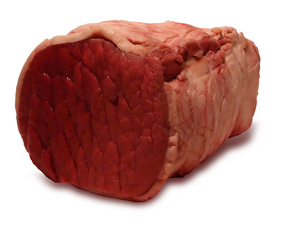Sometimes you are stuck with a piece of roast beef that looks more fit to make into a riding saddle than to eat. But fear not, with a little cooking magic, that unpromising cut can become a feast.
The culprit in this carnivore’s disaster is lack of fat. To the inexperienced cook, the leaner the cut, the better, but the most delicious prime grades of meat receive those accolades because of the rich veins of fat running through them. And, I don’t know if it is just my imagination, but it seems as if meat is tougher these days. When I was a youth, a rump roast or chuck roast routinely called for the cooking techniques that I am about to describe, but not an eye round. Once, an eye round roast was popped right into the oven, but nothing can be taken for granted today.
There are three main techniques for tenderizing a tough roast: marinating, stewing or wrapping fat around the meat.
Let’s start with the first technique: marinating. This is a method for chemically breaking down the tough fibers in the meat. Some people like to use Adolph’s meat tenderizer, which contains the enzyme papaine, a papaya derivative, and in fact, in India, raw papaya has been used for centuries to soften red meats, like goat.
But I like a different marinade: red wine. My southern Italian neighbor’s favorite cooking trick was to take the roast beef and thoroughly saturate it with red wine in a refrigerator overnight. Turn the roast while it is marinating in the red wine so that all sides of the beef are exposed. Red wine is acidic and like the enzyme papaine has the ability to ease tough meat fibers. But, it is not as strong as papaine so the chances of ending up with a mushy mess are reduced.
Red wine also adds a delicious flavor to the meat. After the meat has soaked overnight, lay it in on a foil-covered roasting pan and surround the meat with cut-up pieces of raw potatoes. Lay some pieces of bay leaf on top to season and pop it into a pre-heated oven at 325 degrees. Check periodically for doneness. Discard the bay leaf before serving since the spice is inedible and can cause injury if swallowed.
Stewing is a classic way to render less than desirable pieces of meat edible. I like to add a small roast, some water, a can of condensed mushroom soup and a package of dried onion soup to a slow cooker. Make sure that the entire mixture does not take more than ½ to ¾ of the slow cooker since the boiling juices need space to expand. Start your roast on high heat in the morning Turn the heat down to the lower setting before you leave for work.
On your return, your meal will be cooked and waiting for you. Much cheaper than eating in restaurants night after night when you are too wiped out to cook. Serve this with a some red cabbage (you can buy this already made in a jar) and microwave a baking potato. Add a little sour cream and some chives to the potato and your meal goes from cooker to tabletop in 5 minutes flat. You can get an encore performance by spooning the rich gravy and small pieces of meat over egg noodles to make tomorrow’s lunch or dinner.
If you are home while the meat is cooking, resist the urge to remove the glass cover until you are ready to eat. The slow cooker does not generate high temperatures and constant checking will delay the meal and possibly expose you to danger from roast that is not being cooked at a safe temperature. Remember, keep meat very hot or very cold. Bacteria grow best around room temperature.
Adding fat is also an excellent way to tenderize a roast and some grocers will do it for you. If you shop the meat department of Fresh Direct www.freshdirect.com/index.jsp you can choose to have your roasts delivered tied in twine or untied, with or without added fat. And if you want them to add a little fat, you can specify whether you want white lard or bacon.
A cheaper way to do exactly the same thing is to cook your roast in the oven with pieces of bacon laid on top and baste frequently.
These three basic cooking techniques can be adapted for a variety of meats and cooking situations. Learning how to prepare a basic roast can save time and significant amounts of money.






